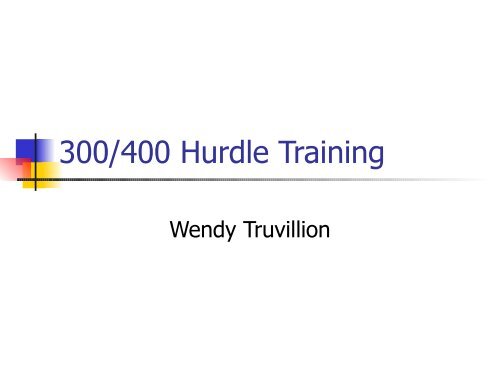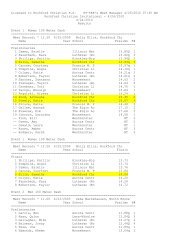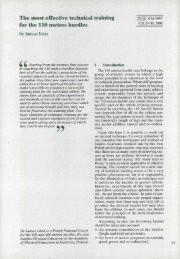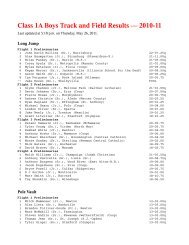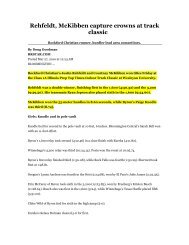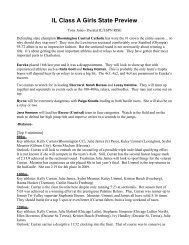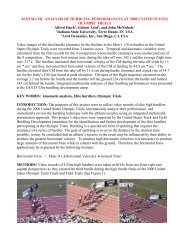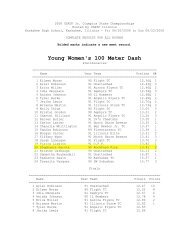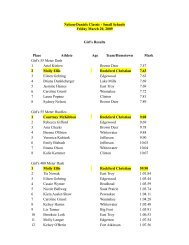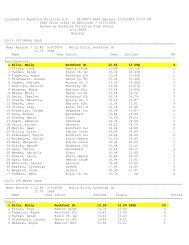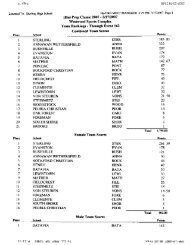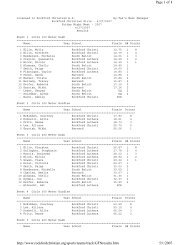300m & 400m Hurdles Presentation 2007 - HurdleCentral.com
300m & 400m Hurdles Presentation 2007 - HurdleCentral.com
300m & 400m Hurdles Presentation 2007 - HurdleCentral.com
Create successful ePaper yourself
Turn your PDF publications into a flip-book with our unique Google optimized e-Paper software.
300/400 Hurdle Training<br />
Wendy Truvillion
Introduction<br />
<br />
<br />
<br />
<br />
Hurdling deviates as least as possible from<br />
normal sprinting.<br />
This hurdle event demands the ability to run<br />
a fast <strong>400m</strong> as wells as possess the stamina<br />
of a 600 – 800m performer.<br />
Our focus, first, last, and always must be<br />
establishing and maintaining SPEED between<br />
and over the hurdles!<br />
The hurdler must learn to hurdle with either<br />
leg.
Specifics to the 300/400<br />
hurdles<br />
<br />
<br />
<br />
<br />
Strides to the first hurdle:<br />
Men:19-23 strides<br />
Women: 22-25 strides<br />
Strides between the hurdles:<br />
Men:12 -15 strides<br />
Women: 14-19<br />
**(developmental hurdlers may need to take more steps until they be<strong>com</strong>e<br />
stronger and faster)<br />
Takeoff distance to the hurdle:<br />
Men: 2.25 -2.30m<br />
Women: 2.04 – 2.05m<br />
Touchdown distance off the hurdle:<br />
Men: 1.22 -1.32m<br />
<br />
Women: 1.10 – 1.25m<br />
**(distances may vary based on non-fatigue and fatigue state)
Measurements in Hurdling<br />
RACE<br />
Distance<br />
to 1 st<br />
Hur<br />
Distance<br />
Between<br />
<strong>Hurdles</strong><br />
Run-In<br />
Distance<br />
off last<br />
hur<br />
Hurdle<br />
Height<br />
400H 45 m 35 m 40 m 30/36”<br />
300H 45 m 35 m 10 m 30/36”<br />
(8H)<br />
200H 16 m 19 m 40 m 30/33”<br />
(5H)
Mechanical Demands<br />
<br />
<br />
<br />
<br />
Learn to hurdle with both<br />
legs.<br />
Attack each hurdle and<br />
negotiate it with which ever<br />
leg that <strong>com</strong>es up in the<br />
process of normal striding<br />
(no studder-step)<br />
Getaway stride with trail leg<br />
is longer than in the sprint<br />
hurdle race.<br />
Economy of motion is<br />
extremely important both<br />
between and over the<br />
hurdle.<br />
<br />
<br />
<br />
<br />
Run the race like a flat<br />
<strong>400m</strong>; avoid unnecessary<br />
deceleration<br />
Allow for the possibility of<br />
leading with the right leg in<br />
the turn, and run toward the<br />
center of the lane to avoid<br />
possible disqualification<br />
Left leg is the preferred lead<br />
leg on the turn<br />
Touchdown times: series of<br />
splits to hit based on goals<br />
and training performances
Technical Demands<br />
<br />
<br />
<br />
<br />
<br />
Apply force at takeoff to<br />
move through the hurdle<br />
and minimize deceleration<br />
Perform effective and<br />
efficient hurdling skills with<br />
both legs<br />
Maintain a consistent<br />
rhythm for 10hurdles<br />
Manage race distribution<br />
efficiently.<br />
Touchdown times: series<br />
of splits to hit based on<br />
goals and training<br />
<br />
<br />
Takeoff to the hurdle is further<br />
away than in the short hurdle<br />
race; allows for a full speed<br />
approach to the hurdle and<br />
efficient trajectory<br />
Drive phase at the start ensures<br />
proper momentum<br />
development, assisting in the<br />
achievement of good running<br />
and hurdling mechanics
Technical Demands<br />
<br />
<br />
<br />
Athlete must have a good<br />
sense of pace and<br />
understand the race plan<br />
and stride pattern<br />
Don’t let the stagger confuse<br />
you; run your race plan<br />
Develop an ability to ‘read’<br />
the hurdle and make<br />
adjustments to negotiate the<br />
barrier without sacrificing<br />
speed and hurdling efficiency<br />
(steering)
Critical Components of the<br />
Race<br />
<br />
<br />
<br />
<br />
Stride length and stride<br />
frequency are inversely<br />
proportional<br />
Aggressive mental approach<br />
with a high level of<br />
concentration<br />
Competitive nature<br />
To over<strong>com</strong>e a variety of<br />
setbacks that can occur<br />
during the race: broken<br />
Strength<br />
<br />
High levels of both maximal<br />
strength and strength<br />
endurance<br />
<br />
<br />
Endurance abilities<br />
Acceleration, absolute<br />
speed, and power
Suggested Training Priorities<br />
<br />
<br />
<br />
<br />
Develop sprinting ability<br />
Develop speed/strength endurance<br />
Rhythm<br />
Lactacid power and capacity<br />
Rhythm Exercises<br />
space hurdles at 19-22m<br />
9-11 strides<br />
Runs over 4-5 hurdles<br />
Runs using non-preferred leg<br />
Acquire and refine steering ability<br />
Runs over 6-9 hurdles at 19-22m<br />
Spacing should be different to force<br />
athlete to ‘read’ hurdle and make<br />
adjustments<br />
Smooth transitions using either leg
Suggested Training Priorities<br />
<br />
<br />
<br />
<br />
Develop maximum and specific strength<br />
and power<br />
Develop ability to race over 200m<br />
Enhance speed and speed<br />
endurance qualities to establish a<br />
baseline for <strong>400m</strong> improvement<br />
Your best <strong>400m</strong> should be<br />
approximately 2x(best 200m)+3.5”;<br />
To this add 2.5-3.5” for a predictor<br />
of best <strong>400m</strong>h performance.<br />
Develop ability to race over <strong>400m</strong><br />
Learn proper distribution of effort<br />
Use 4x<strong>400m</strong> relay with<br />
inexperienced athletes to build<br />
confidence.<br />
Some training should be done over<br />
barriers to rehearse certain segments of<br />
the race
Thank you!<br />
Questions and Answers<br />
References:<br />
USATF Coaches Education Level I and II<br />
Curriculum Manual, 2006


